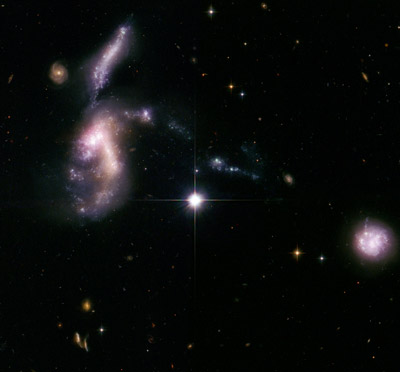Astronomy news
Merging galaxies pose challenge to concept
of evolving universe
15 March 2010
New images by NASA's Hubble Space Telescope show that a group of small,
ancient galaxies — members of a cluster known as Hickson Compact Group
31 — are just beginning the long process of merging together to
form a large elliptical galaxy. Astronomers expect such encounters to
only occur very early on in a universe that is evolving from an
explosive beginning — the Big Bang.
Consequently, according to the Big Bang theory, events of this nature
should only be seen many billions of light-years away. The distance to
these galaxies, however, is a mere 166 million light-years — which is in
our intergalactic backyard.
It has been known for some time that these dwarf galaxies are
gravitationally tugging on each other. Their classical spiral shapes
have been stretched, pulling out long streamers of gas and dust. The
brightest object in the Hubble image is actually two colliding galaxies.
The entire system is aglow with a firestorm of star birth, triggered
when hydrogen gas is compressed by the close encounters between the
galaxies, and collapses to form stars.
The Hubble observations have added important clues to the story of
this interacting group, allowing astronomers to determine when the
encounter began and to predict a future merger.

Hubble image of the Hickson compact group
"We found the oldest stars in a few ancient globular star clusters
that date back to about 10 billion years ago. Therefore, we know the
system has been around for a while," says astronomer Sarah Gallagher of
The University of Western Ontario in London, Ontario, leader of the
Hubble study.
"These galaxies are just coming together for the first time. The
encounter has been going on for at most a few hundred million years, the
blink of an eye in cosmic history. It is an extremely rare local example
of what we think was a quite common event in the distant universe."
The scarcity of these events in relatively nearby regions might seem
itself to be proof of an evolving universe, but in fact in a
non-evolving universe such events would also be rare. This is because
galaxies only spend a very short part of their whole lifespan in such a
state. In the same way, the percentage of one-month-old babies in any
random group of people should also be very low.
Everywhere the astronomers looked in this group of galaxies they
found batches of infant star clusters and regions brimming with star
birth. The entire system is rich in hydrogen gas, the stuff of which
stars are made. Gallagher and her team used Hubble's Advanced Camera for
Surveys to resolve the youngest and brightest of those clusters, which
allowed them to calculate the clusters' ages, trace the star-formation
history, and determine that the galaxies are undergoing the final stages
of galaxy assembly.
The analysis was bolstered by infrared data from NASA's Spitzer Space
Telescope and ultraviolet observations from the Galaxy Evolution
Explorer (GALEX) and NASA's Swift satellite. Those data helped the
astronomers measure the total amount of star formation in the system.
"Hubble has the sharpness to resolve individual star clusters, which
allowed us to age-date the clusters," Gallagher adds.
Hubble reveals that the brightest clusters, hefty groups each holding
at least 100,000 stars, are less than 10 million years old. The stars
have plenty of gas to feed from. A measurement of the gas content shows
that very little has been used up —further proof that the "galactic
fireworks" seen in the images are a recent event. The group has about
five times as much hydrogen gas as our Milky Way Galaxy.
"This is a clear example of a group of galaxies on their way toward a
merger because there is so much gas that is going to mix everything up,"
Gallagher says.
"The galaxies are relatively small, comparable in size to the Large
Magellanic Cloud, a satellite galaxy of our Milky Way. Their velocities,
measured from previous studies, show that they are moving very slowly
relative to each other, just 134,000 miles an hour (60 kilometers a
second). So it's hard to imagine how this system wouldn't wind up as a
single elliptical galaxy in another billion years."
Team member Pat Durrell of Youngstown State University added: "The
four small galaxies are extremely close together, within 75,000
light-years of each other — we could fit them all within our Milky Way."
If the universe is evolving, why did the galaxies wait so long to
interact? Perhaps, says Gallagher, because the system resides in a
lower-density region of the universe, the equivalent of a rural village.
Getting together took billions of years longer than it did for galaxies
in denser areas.
Whether such a solution is correct remains to be seen, especially
given the proximity of the galaxies to our own rather densely populated
region of the universe.
Hickson Compact Group 31 is one of 100 compact galaxy groups
catalogued by Canadian astronomer Paul Hickson.
Gallagher's results appear in the February issue of The
Astronomical Journal.
Sarah Gallagher's team consists of Pat Durrell
(Youngstown State University), Debra Elmegreen (Vassar College), Rupali
Chandar (University of Toledo), Jayanne English (University of
Manitoba), Jane Charlton, Caryl Gronwal, and Jason Young (Penn State),
Panayiotis Tzanavaris (NASA's Goddard Space Flight Center), Kelsey
Johnson (University of Virginia), Claudia Mendes de Oliveira (University
of Sao Paulo), Brad Whitmore (STScI), Ann Hornschemeier (NASA's Goddard
Space Flight Center), Aparna Maybhate (STScI), and Ann Zabludoff
(University of Arizona).
To top |